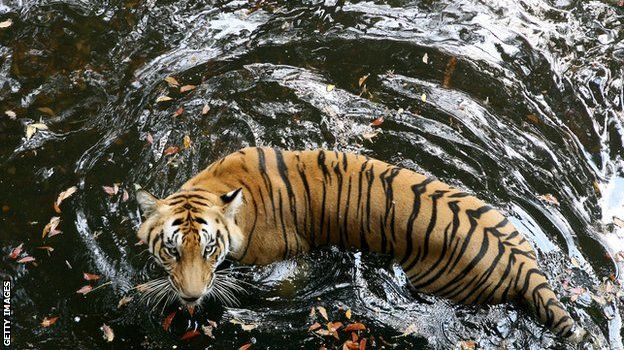Tiger and wild cat trade from Myanmar to China growing
- Published

The trade in tigers and other wild cat parts from Myanmar into China has grown in recent years, a new study based on two decades of survey data suggests.
It reports a surge mainly in Mong La, a Burmese town bordering China, where shops selling such products have more than trebled in the past eight years.
Tiger parts were found in 80 percent of the surveys, the study says, representing at least 200 tigers.
The most common parts were from clouded leopards, numbering some 480 animals.
The findings, published in the journal Biological Conservation, reinforce past claims that the town was emerging as a major wildlife market in the region for products from as far away as Africa.
At the same time, they suggest that in another Burmese town, Tachilek, on the border with Thailand, there has been a fall in trade.
"It could be due to greater enforcement action in Thailand," says report author Chris Shepherd of Traffic, an international wildlife trade monitoring network.
"But because that is yet to happen on the part of China, Mong La has seen the rise in wildlife trade," he added.
Experts say the Burmese authorities have no control over the town, which is run by an armed group following a peace deal with the government.
No government or local official was available for comment.
Dwindling numbers
Burma has banned the trade in tiger and leopard parts, under the international convention against the buying and selling of endangered species (CITES).
Wildlife conservation organisations have told BBC News that the law is not working in Mong La.
"Many of the products, particularly wildlife meat and tiger bone wine, don't enter China but are consumed in Mong La by Chinese tourists," says the World Wildlife Fund's Thomas Grey, in the Greater Mekong area.
"However presumably many of the skins are imported into china as souvenirs.
"So what we need is better enforcement at the border so Chinese tourists are not bringing illegal wildlife products back into China."
The latest study on wildlife products supply from Myanmar to China is based on information gathered from 19 separate surveys of the wild cat trade in Tachilek between 1991 and 2013 and seven surveys between 2001 and 2014 in Mong La.
The surveys recorded a total of over two thousand wild cat parts - mostly skins.
Other products included tigers and leopards' claws, skulls, and canine teeth.
This year there were 21 shops selling some of these parts in Mong La, compared with just six in 2006, the survey found.
China is the world's biggest consumer of tiger products and has been criticised for not doing enough to control its domestic trade.
Earlier this year, the BBC reported that China publicly admitted for the first time that it allowed trade in tiger skins, although buying and selling tiger bones was banned.
Despite growing international concern, poaching of tigers has continued and there are now only around 3,000 of the endangered species left across the globe.
That is only 5% of what the population was a century ago.
Surveyed traders in Burma's Mong La and Tachilek said the tiger and leopard parts reaching China originated from Burmese territory and India.
Experts say the two countries and others in South East and South Asia are now also losing leopards, as demand has shifted to other wild cats in the wake of a dwindling tiger population and stricter wildlife regulations in some countries.
Previous studies have also shown the Burmese town Mong La is emerging as a major centre for other wildlife products, including ivory.
One study, by Oxford Brookes University and Traffic earlier this year, found nearly 3,300 pieces of carved ivory and 49 whole tusks were "openly for sale in Mong La".
"The origin of the ivory may constitute a combination of Asian elephant ivory from Myanmar and African ivory imported via China," the report read.
It said the survey in 2009 found just 25 elephant skin pieces, while between 2013 and 2014 the figure had jumped to 1050.
- Published9 October 2014
- Published12 July 2014